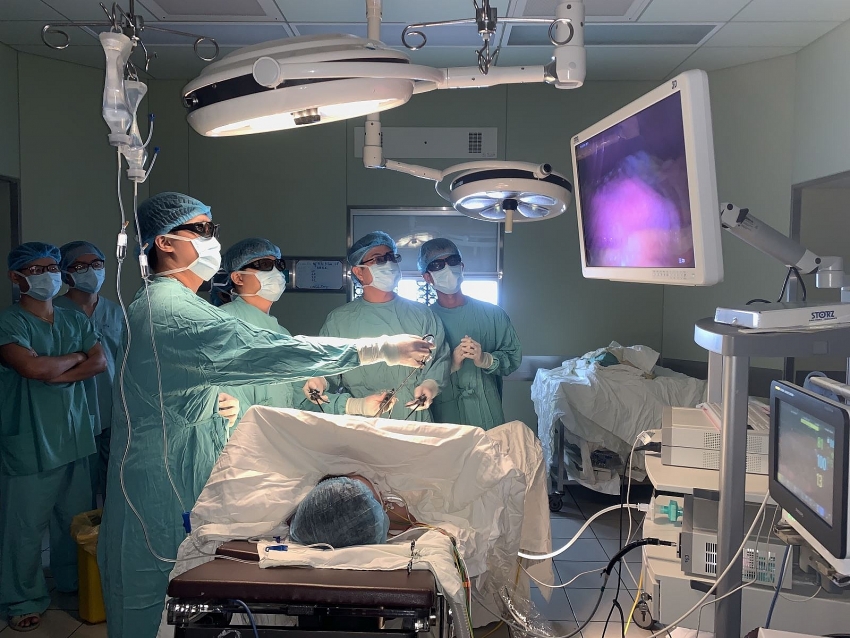Life-saving techniques bring relief to Vietnamese citizens
 |
| High techniques bring relief to Vietnamese citizens |
Having endured a twin pregnancy with common placenta, 27-year-old Vuong Thi Linh from Phuc Tho district in Hanoi burst with happiness after she successfully gave birth to two babies in her 33rd week of pregnancy. As soon as she was diagnosed as having twin embryos with common placenta and blood transfusion syndrome, Linh’s unborn children were treated in the uterus by the doctors at the Hanoi Obstetrics and Gynecology Hospital (HOBH) to ensure they could develop healthily until birth. “Linh was diagnosed very early and entered the hospital in the 12th week of pregnancy.
She was managed in the twins group with a single placenta until the 20th week of gestation when the twin blood transfusion syndrome was discovered,” explained Nguyen Thi Sim, deputy director at the Centre for Screening, Prenatal and Neonatal Diagnosis under the HOBH.
At week 23, the doctors found that one embryo had run out of amniotic fluid and it could not move because of being tightly wrapped, while the other had an abundance amniotic fluid leaving the mother finding it very difficult to breathe. Facing this situation, doctors at HOBH decided to conduct emergency surgery.
“The doctor carefully considered health and survivability of the fetuses when doing the surgery,” said Sim. “Their navel cords were located at the sides and not at the centre of the placenta, meaning it was difficult to nourish them well. We thought a lot before deciding to keep both pregnancies because it was a risky thing.”
Finally, after 40 minutes, the intervention was successful. Linh was closely checked and treated in the following weeks and eventually gave birth to two healthy babies.
“The technique of fetus intervention is the most difficult, even the world’s pinnacle technique in curing and treating unborn children in order to prevent them from harm, but it has a success rate of 90 per cent and is very humane,” Sim asserted.
According to Sim, the two babies have begun to breathe well, and are breastfed and cared for at the Neonatal Department. “So far, our hospital has successfully used this technique for seven cases, five of which were completely implemented by Vietnamese doctors.”
Meanwhile, the Hanoi Heart Hospital (3H) has made an impression on the world with new techniques in cardiology. Over the years, 3H has developed comprehensively in terms of both scale and professional level to become a complete hospital in the field of cardiology with the five specialisations of surgery, intervention, internal medicine, paediatrics, and cardiovascular metabolism.
Nguyen Quang Tuan, director of 3H, said that without key technologies the world would not know about Vietnamese medicine. “This is also a bridge to help patients access modern interventions in the world, right at home with lower costs,” he said.
With the determination to conquer all challenges, the hospital’s physicians have implemented many modern intervention techniques. “We have focused on researching and implementing intensive cardiovascular examination and treatment techniques, aiming to create 5-10 new techniques to be applied in hospitals,” Tuan added.
According to Tuan, Vietnam’s leading intensive techniques, which are on a par with other countries in the region and around the world on cardiovascular interventions, including diagnosing and treating congenital and acquired heart conditions for low-weight newborn babies; extracorporeal membrane oxygenation (ECMO) techniques in case of circulatory failure; and acute respiratory failure.
Another hospital in Hanoi that has contributed to levelling up Vietnam’s medical fortunes is Hanoi Oncology Hospital (HOH), which has also developed a new method of checking and curing patients.
Recognising the increasing demand of being cared for by international experts of high repute while patients’ major barriers are language and geographical distance, HOH has implemented a remote consultation system called Telemedicine.
With this, patients will be consulted online by leading doctors, professors, and oncologists at the hospital as well as others in Singapore, Taiwan, South Korea, and the United States, where the hospital has set up co-operation with others.
Being fully equipped with the latest-generation television equipment systems, data storage, and transmission systems, doctors and physicians can communicate conveniently and give accurate consultation results to determine the best treatment for patients, ensuring the confidentiality of treatment information.
Moreover, Telemedicine will help patients save money, travel time and, above all, give them peace of mind when being treated in an environment familiar to the doctors and relatives, enhancing patient belief in fighting against diseases and other ailments.
Developing new techniques using technologies have transformed Vietnam into a safe and cheaper treatment destination, not only for Vietnamese people but also non-nationals, taking Vietnam’s healthcare system to new heights globally.
What the stars mean:
★ Poor ★ ★ Promising ★★★ Good ★★★★ Very good ★★★★★ Exceptional
 Tag:
Tag:
Related Contents
Latest News
More News
- Protect what’s next: towards a future free from meningococcal group B disease (December 05, 2025 | 18:00)
- New ILO report offers policy recommendations for disability inclusion (December 04, 2025 | 15:18)
- Maternal job loss may affect children’s mental health, research shows (December 03, 2025 | 19:11)
- Women lead Vietnam’s shift to climate-resilient agriculture (December 03, 2025 | 19:10)
- Experts highlight unpaid care work as key barrier to gender equality (December 03, 2025 | 15:15)
- Opportunities and inequalities for women workers in Vietnam's garment industry (December 03, 2025 | 09:00)
- Vietjet flights carry love to devastated central region (November 28, 2025 | 11:35)
- New initiative to boost the fight against domestic violence (November 26, 2025 | 10:00)
- South Korea funds IOM relief for Vietnam’s typhoon-affected communities (November 24, 2025 | 15:33)
- AI and human-centred values set to shape the future of HR in Vietnam (November 21, 2025 | 18:04)





















 Mobile Version
Mobile Version